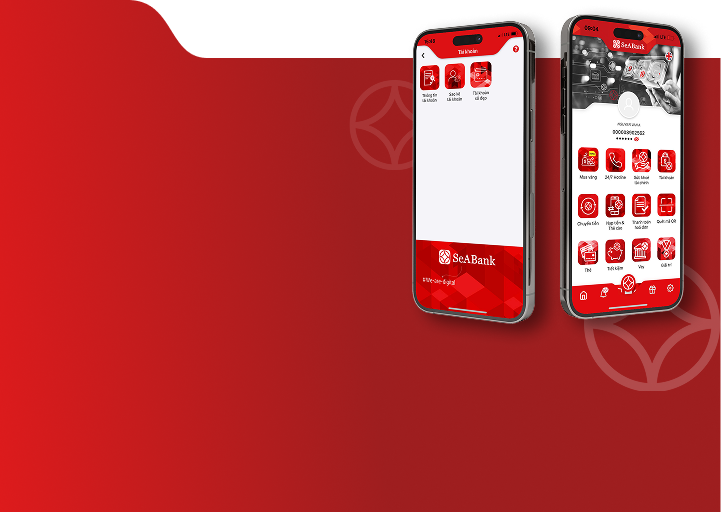News
5+ things to know about closing bank savings books
31/10/2025
Join SeABank to learn clearly the concept, process and secret to effectively closing bank savings books to optimize interest rates and take financial initiative.
In personal financial management, savings are considered one of the safest and most stable investment channels. However, many people still confuse the two concepts of "finalization" and "maturity", leading to withdrawing money at the wrong time and significantly reducing profits. To help you understand the nature of each term, as well as know how to finalize savings accounts effectively and generate optimal profits, the following article will provide specific explanations and detailed instructions.
Quick summary:
- Closing a savings book is the process by which a customer withdraws all principal and interest at the end of the deposit contract at the bank.
- Currently, customers can choose to pay off their loans without a term or with a term (before, on, and after the term) depending on their needs, and do so through many channels such as Mobile Banking, ATM or at the counter.
- To effectively pay off, customers should proactively monitor the maturity date, prioritize online transactions to save time, and use savings books as collateral for loans instead of withdrawing early to still enjoy the full preferential interest rate.
1. What is savings book settlement?
Saving is a safe form of investment, chosen by many Vietnamese people to preserve and make profit from idle money. However, at a certain point, when customers want to use capital or change investment direction, they need to close the savings book. Understanding this concept correctly helps you be more proactive in managing your personal finances, avoiding confusion with similar terms such as "maturity" or "renewal".
1.1. Concept
Closing a savings account is the process of withdrawing all principal and interest from a savings account at a bank at a specified time. When closing is done, the deposit contract between the customer and the bank is officially terminated, and the deposited amount and the accrued interest will be returned to the customer.

The settlement can take place on time or before maturity, depending on the depositor's capital needs. In which:
- Final settlement amount: Is the total value the customer receives, including full principal and interest(calculated according to the interest rate at the time of withdrawal).
- Settlement date: To be the time the customer withdraws money, usually recorded in the banking system to determine the actual interest rate and deposit period.
- Early repayment: Is the work withdraw money before the agreed term in the contract. In that case, the customer will only receive non-term interest.(significantly lower than the original committed interest rate).
Depending on the bank, the settlement process can be done directly at the counter, via Internet Banking or Mobile Banking, helping customers flexibly manage their cash flow.
1.2. Distinguish between final settlement and maturity/due date
In fact, many people often confuse the two concepts of “finalization” and “maturity”. Although closely related, these are two different stages in the life cycle of a savings book.
- Final settlement is the action taken by the customer to withdraw all principal and interest, thereby terminating the validity of the savings book.
- Maturity (or maturity) is the time when the savings book completes the agreed deposit period, meaning the bank has calculated enough interest for the entire term.
The following comparison table helps clarify the differences:
Thus, if the customer makes the final payment on the due date, these two concepts overlap, meaning that the maturity date has just come and the money has been withdrawn to close the book.
2. Forms and timing of savings book settlement
Closing a savings account is not only about withdrawing money from the bank, but also about the time and form of implementation, directly affecting the financial interests of customers. Understanding each form of closing helps you be proactive in choosing the right option, ensuring flexibility when capital is needed and optimizing profits according to savings goals.
2.1. Closing a non-term savings book
This is the most flexible form of savings, for customers who need to use capital regularly or do not have a fixed financial plan.
- Define: Non-term savings books allow customers to withdraw money at any time, without being bound by the deposit period.
- Final settlement time: Not fixed, completely depends on the actual needs of customers.
- Advantage: Provides high flexibility, helping depositors proactively use capital in case of urgent spending or changes in financial plans.
- Disadvantages: Interest rates are significantly lower than term deposits, due to the short deposit period and the difficulty for banks to predict capital sources for investment.

This form is suitable for customers who want to both deposit and withdraw, such as business people who need liquid cash flow or individuals who want to temporarily store money in an interest-bearing account.
2.2. Closing a term savings book
In contrast to the non-term type, term savings books are the most popular form of deposit today. Customers will deposit money for a fixed period of time (usually 1, 3, 6, 12 or 24 months) and the bank will commit to a higher interest rate.
During the deposit process, settlement can take place before the maturity date, on the maturity date, or after the maturity date, depending on the customer's withdrawal time. Each option has its own regulations on benefits and interest rates received.
2.2.1. Early settlement
This is a situation where a customer needs to withdraw money before the maturity date, usually due to unexpected spending needs or changes in financial plans.
- Define: Is the withdrawal of money earlier than the original deposit time agreed with the bank.
- Interest: Customers receive the entire principal back, but interest is only calculated at the non-term interest rate (very low, usually only 0.1%–0.3%/year).
- Advantage: Helps proactively manage capital flow and meet sudden financial needs.
- Disadvantages: Losing the high interest rate that the bank had committed to for the initial term, significantly reduced profits.
Therefore, customers should consider carefully before making early settlement and can choose to divide the deposit into several books to flexibly withdraw money when needed.
2.2.2. Payment on time
This is the ideal time to withdraw money, helping customers receive full profits from their savings.
- Define: Is the withdrawal of the entire principal and interest on the maturity date of the savings book.
- Interest: Customers enjoy full interest according to the contract, calculated for the entire deposit term.
- Advantage: Safe and profit-optimized, suitable for those with long-term financial plans, no need to use capital during the deposit period.
In case the customer does not come to make the final payment on the due date, the bank will apply the post-term processing mechanism (renewal) according to its own regulations.

2.2.3. Final settlement after maturity
Many customers often do not have time to withdraw money on the maturity date, at which time the savings book will be processed according to the bank's automatic renewal mechanism.
- Define: Is the withdrawal of money after the maturity date of the savings book.
- Interest: Depending on each bank's policy, the book can be automatically renewed in one of three forms:
- Renew both principal and interest: The entire amount (principal + interest) will be deposited again according to the old term.
- Principal renewal and interest payment to customers: The interest is transferred to the payment account.
- Renew principal according to new term, interest added to account: Suitable when the bank changes the interest rate schedule.
- Advantage: Helps maintain continuous profits if customers do not need to use money immediately.
- Note: Each bank has a different default renewal policy. Therefore, customers should carefully check the terms before sending to avoid the case of the book being automatically renewed unintentionally.
3. Documents and procedures for closing savings books
Closing a savings account is not simply withdrawing money, but also an important financial procedure to ensure accuracy, security and customer benefits. Depending on the form of closing (online, at ATM or at the counter), the depositor needs to prepare documents and follow the process according to the bank's instructions.
3.1. Documents to prepare
Before making final payment, customers should prepare all relevant identification documents and certificates to help the process go quickly, smoothly and limit risks.
Specifically, the dossier includes:
- Savings book or deposit certificate (original or electronic copy, depending on the form of deposit).
- Valid ID card/CCCD/passport to verify the identity of the book owner.
- The settlement form provided by the bank, with the signature matching the signature registered when opening the book.
- Legal power of attorney (if someone else is acting on your behalf), with copies of both parties' identification documents.
Preparing correct and complete documents is key for the bank to authenticate the owner, especially for large value transactions or over-the-counter settlements.
3.2. Final settlement process
Nowadays, banks deploy many flexible settlement channel, meeting customers' needs, from digital platforms such as Mobile Banking, Internet Banking, to traditional channels at ATM/CDM or directly at the counter. Each method has its own advantages, helping senders choose according to their personal habits and conditions.
3.2.1. Payment via Mobile Banking / Internet Banking
With the development of digital banking, online payment is becoming more and more popular, especially with young customers or those who need quick transactions.

- Conditions for implementation: Customers must have SeAMobile or SeANet account(depending on the bank), registered for electronic banking services and linked to an electronic savings book.
- Steps to follow:
- Log in to Mobile Banking or Internet Banking application.
- Select the savings product being deposited.
- Click “Finish”, choose the method of receiving money (to payment account or renew).
- Transaction authentication by OTP code or biometrics (fingerprint/face).
- Advantage: This form helps customers proactively make payments anytime, anywhere, no need to go to the counter, ensuring speed, safety and time savings.
3.2.2. Payment at ATM / CDM
This is an intermediate option between online and counter transactions, suitable for customers using electronic savings books linked to bank cards. The feature of closing savings books at ATM/CDM depends on each bank, because most machines are mainly used for withdrawals, deposits or transfers. Customers should check in advance whether the bank they are using supports this feature or not.
- Conditions for implementation: Only applicable to electronic savings book, directly linked to card account or payment account.
- Operation steps:
- Insert your card into the ATM/CDM and log in with your PIN.
- Select “Savings settlement” on the screen.
- Confirm savings account information and choose payment method.
- The system will transfer principal and interest to the linked account.
- Important Note: Customers should check the transaction fee schedule (if any) in advance and ensure the security of personal information, avoid doing it on strange machines or in crowded public places.
3.2.3. Direct payment at the transaction counter
This is the traditional method and is still chosen by many customers, especially when needing to withdraw large amounts of cash or wanting direct support from bank staff.
- Documents required:
- Valid ID card/CCCD/passport
- Original savings book
- Implementation process:
- Submit application to teller.
- The bank checks and verifies the information, including signature, book number, deposit amount and term.
- Customer signs to confirm payment, chooses method of receiving money (cash or bank transfer).
- Receive money or transaction statement completed.
- Advantage:
- There are direct support staff to ensure accurate and safe procedures.
- Suitable for large value transactions, need to be clearly verified.

This method takes time to travel but brings high reliability and suitable for customers who prioritize absolute safety when withdrawing money.
4. Secrets to effectively closing savings books
Closing a savings account seems like a simple operation, but if you know how to manage and choose the right time, customers can optimize profits, maintain liquidity and avoid losing interest benefits. Below are some tips to help close the account more effectively and intelligently.
4.1. Avoid losing interest when you need money urgently
One of the most common mistakes when making a savings deposit is to withdraw money before maturity whenever there is an urgent need for spending. This causes customers to lose all preferential interest rates, and only enjoy a very low non-term interest rate.

Instead of closing the book, customers can use the savings book as collateral to borrow capital from the bank. This is a popular form implemented by many banks, helping:
- Maintain interest benefits of savings book.
- Get a quick loan without collateral.
- Preferential interest rates, lower than regular loans.
This method helps customers have capital to use immediately and continue to make profit on the initial deposit, especially suitable in cases where short-term capital or temporary disbursement is needed.
4.2. Proactively monitor maturity dates
Forgetting or missing the maturity date can cause the savings book to automatically renew, changing the financial plan or causing customers to miss the opportunity to withdraw interest at the right time. Therefore, proactively monitoring and managing the maturity schedule is very important.
Some ways to help you stay in control of your payment timing:
- Set reminders on your phone or personal finance app.
- Activate the "automatic maturity reminder" feature on e-banking applications such as SeAMobile, helping the system send notifications when the withdrawal date is approaching.
Regular monitoring not only helps avoid the risk of unwanted renewal, but also helps customers proactively compare new interest rates to decide whether to continue depositing or switch to another more attractive product.
4.3. Prioritize online payment to save time
With the development of digital banking technology, customers can completely close their savings books in just a few steps on their phone or computer, without having to go to the transaction counter.
Outstanding advantages:
- Quick and easy operation, transaction takes only a few minutes.
- No need to wait in line, save time.
- Highly secure with OTP or biometric authentication.
- Suitable for small, urgent or frequent payments.
In addition, online settlement also helps customers easily manage their electronic savings book portfolio, track interest rates, transaction history and renew with just a few steps. This is a trend that is being chosen by most young customers thanks to its safety, convenience and initiative.
Security Note: SeABank Never ask customers to provide OTP codes, login information or transfer money to "close the book". Customers should only perform transaction via SeAMobile application or at the official counter to ensure safety.
Understanding and properly applying the finalization of savings books not only helps to preserve interest benefits, but also helps you manage cash flow more effectively. Whether choosing the form of finalization online or at the counter, customers should maintain the habit of controlling the deposit schedule, maturity, renewal to ensure optimal profits and always proactive financial planning.
To enjoy flexible, safe and effective savings and settlement solutions, join SeABank - the bank that always accompanies you to help you manage your finances in the smartest way.
Related News
[Detailed answer] Why does online savings have higher interest rates? 31/10/2025
What is the maturity date of a savings book? All the information you need to know from A–Z 31/10/2025
Can I borrow more while paying installments? Detailed answers 31/10/2025
What is a bank installment loan? Experience in safe borrowing, low interest rates 31/10/2025
What is CIC? 3 Ways to Check Personal Credit History 31/10/2025
![[Detailed answer] Why does online savings have higher interest rates?](https://cloud-cdn.seabank.com.vn/seabank-web/tai-sao-gui-tiet-kiem-online-lai-suat-cao-hon.png)
[Detailed answer] Why does online savings have higher interest rates?
Why online savings have higher interest rates is a question of many customers. Refer to this article immediately for answers and choose the appropriate form.
31/10/2025
Read more

What is the maturity date of a savings book? All the information you need to know from A–Z
Join SeABank to learn what savings book maturity is, how to calculate, process and important notes to optimize interest rates and protect rights.
31/10/2025
Read more

Can I borrow more while paying installments? Detailed answers
Find out what an installment loan is and whether you can get another loan while you are on installment. Discover the terms, conditions, and important things to consider before taking out another loan
31/10/2025
Read more







